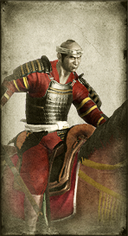
Basic Unit Statistics (can be modified by difficulty level, arts, skills, traits and retainers)
| Recruitment Cost | 990 | |
| Upkeep Cost | 130 | |
| Melee Attack | 10 | 28% |
| Charge Bonus | 15 | 30% |
| Bonus vs Cavalry | 15 | 50% |
| Melee Defence | 4 | 11% |
| Armour | 4 | 26% |
| Morale | 8 | 16% |
Strengths & Weaknesses
- Average in melee.
- Very good charge.
- Weak melee defence.
- Very good against cavalry.
- Weak against missile attacks and spear-armed units.
- Good morale.
Abilities
- Wedge Formation - Trained to charge in a wedge formation in order to better penetrate enemy formations
Requires
Description
These spear-armed horsemen can be incredibly effective in attacks against enemy cavalry.
There is much to be said in favour of the traditional cavalry charge, an attack that strikes fear into the hearts of the enemy as you thunder forwards. However, with the introduction of modern weapons the charge should be used with some caution, and only employed when the desired effect will be achieved. Best employed against enemy cavalry, yari ki should never be sent against rifle and spear units or left in prolonged melee combat. Instead they should be used for flanking manoeuvres and attacks where they can make a quick getaway. Horses tend to play minor roles in the mythology of Japan. More importance is often placed on powerful weapons and great deeds. However, Chokwaro, one of the eight Taoist immortals, who was believed to be a great necromancer, was accompanied everywhere by a white horse that could carry him great distances. In China he is often shown with a bamboo tube, but in Japan his emblem is a gourd. According to legend it is from this gourd that his white horse rides forth. When Chokwaro pours water from it or spits into it the horse appears and, never tiring, carries him for many miles.